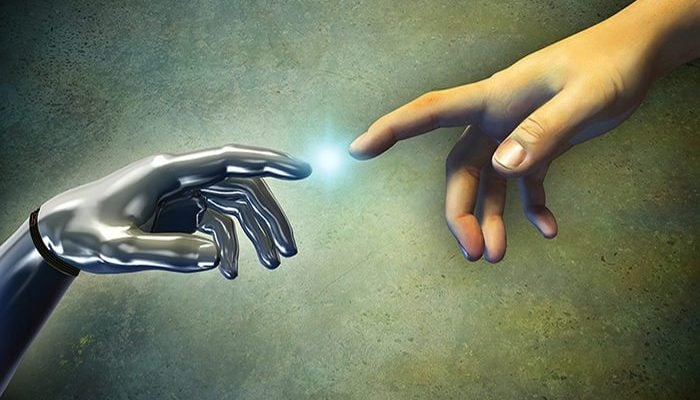IoT + AR in Field Service: Convergence of the Physical and the Digital
Oct 24, 2018 • Features • Augmented Reality • Connected Field Service • Future of FIeld Service • future of field service • Mark Brewer • Remote Assistance • field service • field service management • IFS • Internet of Things • Service Management • Managing the Mobile Workforce
Mark Brewer looks at how and why the two big technologies that are set to alter our industry forever are likely to converge...
To most people, the idea of a Digital Twin is largely just that - an idea. The concept may make sense, but they can’t be sure they’ve actually seen it demonstrated in the real world. Or at least not in any useful everyday purpose... yet.
It’s different for those working in Field Service.
Digital Twin is on everyone’s lips, an exciting buzzword that’s changing the shape of the sector and opening the door to new possibilities.
Forward-thinking Field Service organisations are already factoring it into their planning and monitoring activities and may even be deploying it where they can.
Why is Digital Twin such a hot ticket in our world?
Raising the game
The focus of Field Service centres on improving the reliability of an organisation’s assets. By enabling them to operate efficiently for longer, with less maintenance, you enjoy a greater return on investment while also spending less on upkeep and parts.
Clearly, the ability to accurately predict potential problems in those assets before they happen is a big help in achieving the above. Even more so, if steps can then be taken to not only rectify these issues but also provide a better experience for customers.
"A study by The Service Council found that four in ten incomplete service visits to fix equipment would benefit from the use of live video or AR..."
AR combined with the Internet of Things (IoT) does all this... which explains why the Field Service sector is so excited about it. The result is known as the Digital Twin – creating a bridge between the physical and the digital.
A study by The Service Council found that four in ten incomplete service visits to fix equipment would benefit from the use of live video or AR
Better connectivity, together with more accessible relevant tools were considered to improve the speed and quality of issue resolution - meaning that less pressure is put on company resources on-site.
A remote revolution
Thinking about practical examples, it’s not too difficult to see what a difference a Digital Twin would make, almost immediately.
Imagine you’re maintaining an elevator that’s installed in one of your customer’s offices.
Thanks to AR, your engineers can view a digital representation of that elevator, on their screen in your offices or on the road on their iPad, nowhere near the physical location of the asset. They can monitor operations virtually, from the comfort of their desk and without having to visit the elevator.
The 3D model on their screen is generated using engineering data with the output of the various sensors installed on the physical equipment augmented onto this. Some show power consumption, to see how efficiently things are running. Others might show spikes in voltage or the level of vibration and wear generated by the hoist as it runs up and down the building floors, whilst also indicating the number of trips completed and speed.
"On-screen augmentations and animated sequences give those involved an accurate visual indicator of any parts required, and how they may be assembled or disassembled..."
In short, it gives your engineer a comprehensive insight into the status and performance of the equipment.
When an issue does arise or a part needs replacing or upgrading, instead of having to drop everything and go directly to the site, they may instead be able to talk to a trained individual who may be based on-site, and direct them through the repair/replace process. Using a connected device such as an iPad or laptop, the on-site employee can share live footage and follow the remote engineer’s lead to perform the required maintenance.
On-screen augmentations and animated sequences give those involved an accurate visual indicator of any parts required, and how they may be assembled or disassembled. What’s more, the engineer can tag other team members who may either have useful knowledge to contribute or might just want to learn how to perform the task for next time around.
Sharing knowledge
Given that service parts and equipment are becoming increasingly complex and expensive, this process offers a great alternative for Field Service providers to continue providing excellent service while improving uptime and consequently saving customers time and money.
Moreover, it promotes the idea of ‘democratised knowledge’ - the sharing and passing on of vital skills and expertise from experienced engineers to workers that are onboarding. This way, as the seasoned workforce ages, their insights are therefore not lost but live on in even more tech-savvy younger employees. Which is a huge benefit when it comes to training and upskilling.
As said, the benefits of the Digital Twin in Field Service could be game-changing which is why so many of us in the industry are talking about it. Looking beyond predictive maintenance, the Digital Twin also opens up the opportunity to provide value-add recommendations to your customer in the use and operation of your equipment, as well as giving valuable insights to your own R&D organisation for future engineering changes.
What could the Digital Twin mean to you, your organisation and the service levels you are able to deliver to your customers?
Mark Brewer, is Global Industry Director, Service Management, IFS
Be social and share





















 Field Service News is published by 1927 Media Ltd, an independent publisher whose sole focus is on the field service sector. As such our entire resources are focused on helping drive the field service sector forwards and aiming to best serve our industry through honest, incisive and innovative media coverage of the global field service sector.
Field Service News is published by 1927 Media Ltd, an independent publisher whose sole focus is on the field service sector. As such our entire resources are focused on helping drive the field service sector forwards and aiming to best serve our industry through honest, incisive and innovative media coverage of the global field service sector.
Leave a Reply